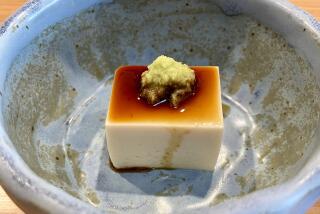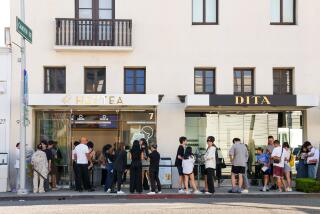Drinking In the Beauty of Japanese Tea Ceremony
- Share via
Every move at the Japanese tea ceremony came with choreographed precision: the scooping of the powdered green tea into a handmade cup, the stirring with a bamboo whisk and the serving.
“This is an aesthetic discipline,” said Dorian Hunter, explaining a ceremony last week at Cal State Fullerton. “It’s very respectful, very authentic.”
The ceremony marked the opening of the university’s exhibit “Tea Party” in the library’s Atrium Gallery. The exhibit, running through Dec. 16, includes a display of tea-inspired arts and traditions. There are books, a Dresden teapot, a Yixing teapot, Chinese cups and Italian utensils.
Tea master Soyu Koizumi of the Orange County chapter of the School of Urasenke and some of her students performed the ceremony Friday. Their stage resembled a traditional tearoom, with a bamboo vase holding wildflowers, a kama (kettle) brewing the tea and a scroll that read in Japanese: “Not even one speck of cloud is in the sky.”
“The Zen meaning is that everything is very well,” said Hunter, one of Koizumi’s pupils.
“A sweet is served before the tea,” she noted as guests at the ceremony ate sugary Japanese pastries. “And the tea is very thin. It’s an informal type of tea. There are two kinds of tea in Japan, thick and thin, but there are 200 ways of serving it.”
Children, traditionally, get their first tea-ceremony lesson when they are 6 years, 6 months and 6 days old, she added. “Everything is very prescribed.”
Kim Kanahele, 32, a Cal State Fullerton music student, watched in awe.
“From the minute they enter and sit on the mat, they take time to admire each utensil,” she said. “I think they do that because this is so beautiful. It’s about seeing the beauty in it. It’s very spiritual.”
Added Koizumi: “It’s a way of life in Japan. When you’re cleaning the bowl with the silk cloth, it’s like purifying your own soul.”
More to Read
Eat your way across L.A.
Get our weekly Tasting Notes newsletter for reviews, news and more.
You may occasionally receive promotional content from the Los Angeles Times.









